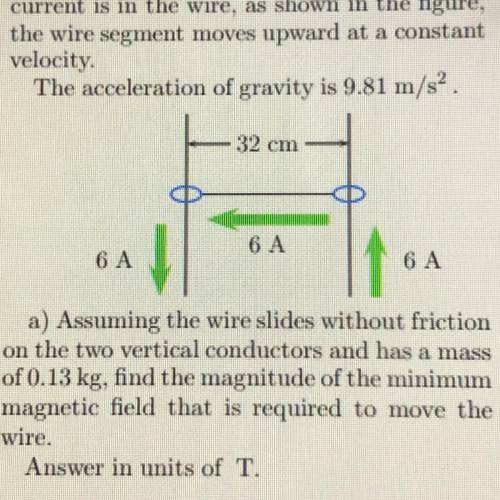In the figure, a 32 cm length of conducting
wire that is free to move is held in place
betwee...

Physics, 31.03.2021 21:40 fatherbamboo
In the figure, a 32 cm length of conducting
wire that is free to move is held in place
between two thin conducting wires. All of the
wires are in a magnetic field. When a 6.0 A
current is in the wire, as shown in the figure,
the wire segment moves upward at a constant
velocity.
The acceleration of gravity is 9.81 m/s?.
32 cm
6 A
6 A
a) Assuming the wire slides without friction
on the two vertical conductors and has a mass
of 0.13 kg, find the magnitude of the minimum
magnetic field that is required to move the
wire.
Answer in units of T.


Answers: 3


Another question on Physics

Physics, 21.06.2019 20:40
If an object with an initial temperature of 300 k increases its temperature by 1°c every minute, by how many degrees fahrenheit will its temperature have increased in 10 minutes? (a) 6°f (b) 10°f (c) 18°f (d) 30°f
Answers: 3

Physics, 21.06.2019 22:50
Two horizontal plates with infinite length and width are separated by a distance h in the z direction. the bottom plate is moving at a velocity u. the incompressible fluid trapped between the plates is moving in the positive x-direction with the bottom plate. align gravity with positive z. assume that the flow is fully-developed and laminar. if the systems operates at steady state and the pressure gradient in x-direction can be ignored, do the following: 1. sketch your system 2. identify the coordinate system to be used. 3. show your coordinates and origin point on the sketch. list all your assumptions. 5. apply the continuity equation to your system. nts of navier stokes equations of choice to your system 7. solve the resulting differential equation to obtain the velocity profile within the system make sure to list your boundary conditions. check units of velocity 8. describe the velocity profile you obtain using engineering terminology. sketch that on the same sketch you provided in (1). 9. obtain the equation that describes the volumetric flow rate in the system. check the units.
Answers: 2

Physics, 22.06.2019 02:00
Chapter 23, problem 075 the figure shows a geiger counter, a device used to detect ionizing radiation (radiation that causes ionization of atoms). the counter consists of a thin, positively charged central wire surrounded by a concentric, circular, conducting cylindrical shell with an equal negative charge. thus, a strong radial electric field is set up inside the shell. the shell contains a low-pressure inert gas. a particle of radiation entering the device through the shell wall ionizes a few of the gas atoms. the resulting free electrons (e) are drawn to the positive wire. however, the electric field is so intense that, between collisions with gas atoms, the free electrons gain energy sufficient to ionize these atoms also. more free electrons are thereby created, and the process is repeated until the electrons reach the wire. the resulting "avalanche" of electrons is collected by the wire, generating a signal that is used to record the passage of the original particle of radiation. suppose the radius of the central wire is 24 âµm, the inner radius of the shell 2.3 cm, and the length of the shell 14 cm. if the electric field at the shell's inner wall is 2.8 ă— 104 n/c, what is the total positive charge on the central wire?
Answers: 1

You know the right answer?
Questions



Biology, 29.08.2019 19:50

Biology, 29.08.2019 19:50



Mathematics, 29.08.2019 19:50

Social Studies, 29.08.2019 19:50

Biology, 29.08.2019 19:50

Mathematics, 29.08.2019 19:50

English, 29.08.2019 19:50



Physics, 29.08.2019 19:50


Physics, 29.08.2019 19:50

Health, 29.08.2019 19:50

Physics, 29.08.2019 19:50

Mathematics, 29.08.2019 19:50



